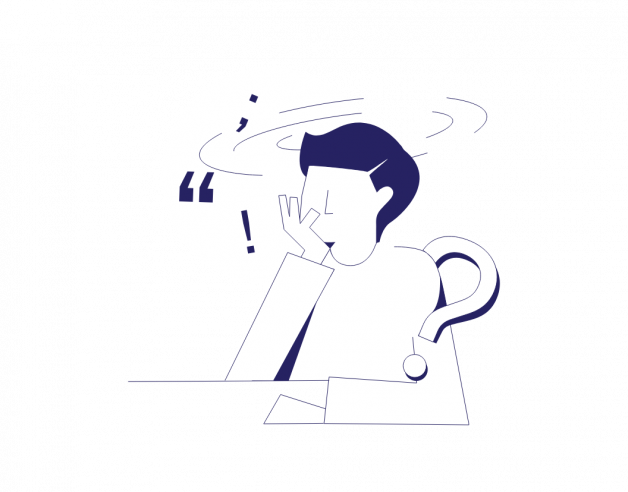
- 5-minute read
- 12th February 2023
Punctuation Tips: Apostrophes
An apostrophe (’) is a punctuation mark used to indicate possession, omitted letters, or numbers in English. In this article, you’ll learn the rules for using apostrophes and look at some examples and common mistakes.
Possessive Apostrophes
Possessive apostrophes indicate ownership of something. There are a few rules for using an “s” with an apostrophe after a noun, along with some exceptions.
The Basic Rule
For any singular noun to show possession of something/someone, you simply add “s” after the apostrophe:
Catherine‘s boyfriend
Bobby‘s backpack
My mom‘s favorite recipe
For singular nouns that end in “s,” the extra “s” after the apostrophe is optional, and the decision will often come down to how it sounds when read aloud:
The bus‘s arrival
The hostess‘s chair
My boss‘s office
James’ sister
Mr. Jarvis’ class
For plural nouns ending in “s,” only add an apostrophe to the end of the possessive noun.
The soccer teams’ coaches
My parents’ house
Exceptions to the Rule
As with any grammar or punctuation rule in English, there are always exceptions.
Plural Nouns That Do Not End in “S”
For plural nouns that don’t end in “s,” you’ll need to add an extra “s” after the apostrophe to show possession (as if they were a singular noun).
The women‘s bathroom
Men‘s shoes
Some Names Ending with “S”
For some names that end in “s,” you can leave out the “s” after the apostrophe if it will result in an extra “s” syllable. You’ll have to read the name out loud to hear if this is an issue. Try saying these out loud:
Ulysses‘s companions
The extra “s” at the end doesn’t sound natural – it makes you sound like a snake! To avoid this, leave out the extra “s” when writing the word:
Ulysses’ companions
Common Phrases Using Possessive Apostrophes
For these phrases, you’ll become familiar with them as you use them. Here’s a short list of some examples:
All in a day’s work: something that’s usually difficult to do but is accepted as part of someone’s normal routine.
In a week’s time: One week from now.
In a day’s time: 24 hours from now (or “in two days’ time,” “in three days’ time,” etc.).
Common Mistakes with Possessive Apostrophes
Possessive pronouns do not use an apostrophe under any circumstances. This is because they already show possession (the clue is in the name), so they don’t need the help of an apostrophe. Possessive pronouns include his, hers, ours, theirs, its, yours, and mine:
Note: Using “its” for “it’s” and vice versa is a common mistake when writing. Therefore, it’s important to proofread your writing before submitting work or hitting send on an email. Making this type of error could reflect poorly on you as a writer.
For compound nouns, where the apostrophe goes will depend on whether the nouns act jointly or independently.
(John’s dog and Sara’s dog both went to the park. They do not own dogs together.)
(John and Sarah own dogs as a couple, and their dogs went to the park.)
Apostrophes are not used to make a noun plural:
Find this useful?
Subscribe to our newsletter and get writing tips from our editors straight to your inbox.
This – sometimes called the “grocer’s apostrophe” – is something you should specifically check for in your writing, as it’s a common mistake.
Apostrophes and Contractions
Apostrophes are also used to indicate omitted letters in contractions. A contraction is a combination of two words that have been shortened by omitting one or more letters.
Cannot → can’t
Should have → should’ve
It is → it’s
I am → I’m
Will not → won’t
Note: Contractions are considered informal, so avoid using them in formal writing, such as in academic or business writing.
Apostrophes and Numbers
Apostrophes are also used in place of omitted numbers or to indicate a range of years.
Class of ’15 = People who graduated in 2015
Conclusion
The correct usage of apostrophes can be tricky and may require some practice and attention to detail. However, by understanding the basic rules and exceptions and being mindful of common mistakes, you can improve your use of apostrophes to ensure neat and error-free writing.
FAQs
How Do You Use Apostrophes To Indicate Possession?
- For singular nouns, add an apostrophe and an “s” to the end of the noun.
- For singular nouns ending in “s,” the extra “s” after the apostrophe is optional.
- For most plural nouns, add only an apostrophe to the end of the noun.
What Is the Difference Between Possessive Apostrophes and Contractions?
- Possessive apostrophes are used to indicate that a noun has possession of something or someone. For example, “My mother’s favorite recipe.”
- Contractions are shortened versions of two words. For example, “I am → I’m” or “should have → should’ve.”
Do Possessive Pronouns Like “Mine” and “Yours” Still Require Apostrophes?
No. Do not add apostrophes with possessive nouns. They already indicate possession, so apostrophes are not required.
Do I Need to Add an Apostrophe and an “S” to Show That a Noun Is Plural?
No. The plural of a noun is formed without using an apostrophe.
How Can I Get Someone To Check My Apostrophe Usage?
If you need help with grammar, apostrophes, or any other punctuation in English, our experts are here to help. Try a free sample of our service today!






